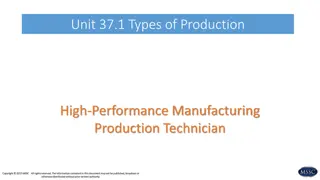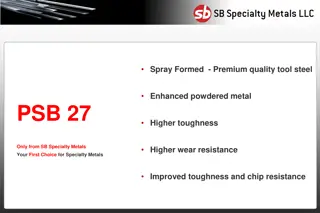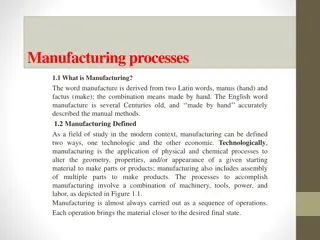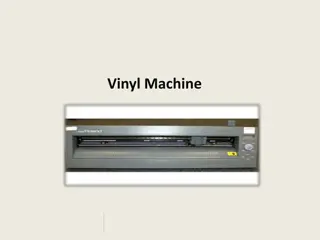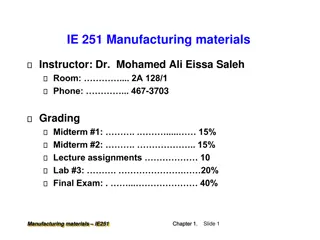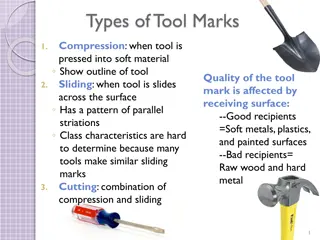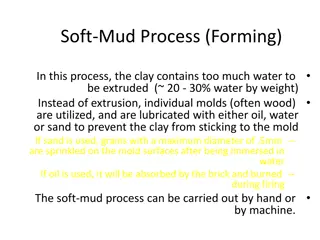Overview of Cutting Tool Materials in Manufacturing Process
Cutting tool materials play a crucial role in the manufacturing process, encountering high temperatures, stresses, and friction. Materials like high-speed steels, cast-cobalt alloys, and carbides offer varying properties such as hardness, toughness, and wear resistance to meet the demands of cutting operations. Each material has its unique characteristics and applications, providing options for different machining requirements.
Uploaded on Sep 29, 2024 | 0 Views
Download Presentation

Please find below an Image/Link to download the presentation.
The content on the website is provided AS IS for your information and personal use only. It may not be sold, licensed, or shared on other websites without obtaining consent from the author. Download presentation by click this link. If you encounter any issues during the download, it is possible that the publisher has removed the file from their server.
E N D
Presentation Transcript
Subject Name: Manufacturing Process Subject Code: 10ME-35 Prepared By: Radha Krishnan P& Ravi Shankar .M Department: Aeronautical Engineering Date : 18.11.2014
Chapter Outline Introduction High Speed Steels Cast-cobalt alloys Carbides Coated Tools Alumina-based ceramics Cubic boron Nitrade Cutting Fluids
Introduction Cutting tool is subjected to: 1. High temperatures, 2. High contact stresses 3. Rubbing along the tool chip interface and along the machined surface Cutting-tool material must possess: 1. Hot hardness (see right) 2. Toughness and impact strength 3. Thermal shock resistance 4. Wear resistance 5. Chemical stability and inertness
Introduction Tool Materials (also used for dies and molds in casting, forming, and shaping metallic and non-metallic materials): 1. High-speed steels 2. Cast-cobalt alloys 3. Carbides 4. Coated tools 5. Alumina-based ceramics 6. Cubic boron nitride 7. Silicon-nitride-based ceramics 8. Diamond 9. Whisker-reinforced materials and nano materials
High-speed Steels High-speed steel (HSS) tools were developed to machine at higher speeds than was previously possible They can be hardened to various depths, have good wear resistance and are inexpensive There are two basic types of high-speed steels: molybdenum (M-series) and tungsten (T-series) High-speed steel tools are available in wrought, cast and powder-metallurgy (sintered) forms They can be coated for improved performance
Cast-cobalt Alloys Cast-cobalt alloys have high hardness, good wear resistance and can maintain their hardness at elevated temperatures They are not as tough as high-speed steels and are sensitive to impact forces Less suitable than high-speed steels for interrupted cutting operations
Carbides Also known as cemented or sintered carbides They have the following characteristics: 1. High hardness over a wide range of temperatures 2. High elastic modulus 3. High thermal conductivity 4. Thermal expansion 5. Versatile 6. Cost-effective tool and die materials for a wide range of applications
Carbides: Tungsten Carbide Tungsten carbide (WC) consists of tungsten- carbide particles bonded together in a cobalt matrix As the cobalt content increases, the strength, hardness, and wear resistance of WC decrease Its toughness increases because of the higher toughness of cobalt
Carbides: Titanium Carbide Consists of a nickel molybdenum matrix Has higher wear resistance than tungsten carbide but is not as tough Suitable for machining hard materials and for cutting at speeds higher than tungsten carbide
Coated Tools New alloys and engineered materials are being developed to have high strength and toughness, abrasive and chemically reactive with tool materials Coatings have unique properties: 1. Lower friction 2. Higher adhesion 3. Higher resistance to wear and cracking 4. Acting as a diffusion barrier 5. Higher hot hardness and impact resistance
Coated Tools: Coating Materials and Coating Methods Coatings are applied on cutting tools and inserts by two techniques: 1. Chemical-vapor deposition (CVD) 2. Physical-vapor deposition (PVD) Coatings have the following characteristics: 1. High hardness 2. Chemical stability and inertness 3. Low thermal conductivity 4. Compatibility and good bonding 5. Little or no porosity
Coated Tools: Miscellaneous Coating Materials Titanium carbonitride and titanium-aluminum nitride are effective in cutting stainless steels Chromium carbide is effective in machining softer metals that tend to adhere to the cutting tool More recent developments are nanolayer coatings and composite coatings
Coated Tools: Ion Implantation Ions are introduced into the surface of the cutting tool, improving its surface properties Process does not change the dimensions of tools Nitrogen-ion implanted carbide tools have been used successfully on alloy steels and stainless steels
Alumina-based Ceramics Ceramic tool materials consist of fine-grained and high-purity aluminum oxide Additions of titanium carbide and zirconium oxide improve toughness and thermal shock resistance Alumina-based ceramic tools have very high abrasion resistance and hot hardness
Alumina-based Ceramics Cermets Consist of ceramic particles in a metallic matrix They are chemical stability and resistance to built-up edge formation But they are brittle, expensive and limited usage
Cubic Boron Nitride Cubic boron nitride is the hardest material available Carbide provides shock resistance, high wear resistance and cutting-edge strength At elevated temperatures, it is chemically inert to iron and nickel Its resistance to oxidation is high and suitable for cutting hardened ferrous and high-temperature alloys
Silicon-nitride-based Ceramics Silicon-nitride (SiN) based ceramic tool materials consist of silicon nitride with various additions of aluminum oxide, yttrium oxide and titanium carbide Tools have high toughness, hot hardness and good thermal-shock resistance Due to chemical affinity to iron at elevated temperature, SiN-based tools are not suitable for machining steels
Cutting Fluids Cutting fluids is used to: 1. Reduce friction and wear 2. Cool the cutting zone 3. Reduce forces and energy consumption 4. Flush away the chips from the cutting zone 5. Protect the machined surface from environmental corrosion Depending on the type of machining operation, a coolant, a lubricant, or both are used Effectiveness of cutting fluids depends on type of machining operation, tool and workpiece materials and cutting speed
Cutting Fluids Cutting-fluid Action Cutting fluid seep from the sides of the chip through the capillary action of the interlocking network of surface asperities in the interface Discontinuous cutting operations have more straightforward mechanisms for lubricant application, but the tools are more susceptible to thermal shock
Cutting Fluids Methods of Cutting-fluid Application 4 basic methods: 1. Flooding 2. Mist 3. High-pressure systems 4. Through the cutting tool system
Cutting Fluids Effects of Cutting Fluids Selection of a cutting fluid based on: 1. Workpiece material and machine tools 2. Biological considerations 3. Environment Machine-tool operator is in close proximity to cutting fluids, thus health effects is a primary concern Progress has been made in ensuring the safe use of cutting fluids Recycling involves treatment of the fluids with various additives, agents, biocides, deodorizers and water treatment
Cutting Fluids: Near-dry and Dry Machining Near-dry cutting is the application of a fine mist of an air fluid mixture containing a very small amount of cutting fluid Dry machining is effective on steels, steel alloys, and cast irons, but not for aluminum alloys One of the functions of a metal-cutting fluid is to flush chips from the cutting zone Cryogenic Machining Using nitrogen or carbon dioxide as a coolant The chips are more brittle and machinability is increased
Summary Introduction: Metal cutting processes involve high local stresses, friction and considerable heat generation during cutting. Classification of cutting tool materials: HSS, cast cobalt alloys, Carbides, Coated tools, Ceramics, Cubic Boron Nitride . Cutting Fluids: A cutting fluid or a coolant is a liquid, added to the cutting zone to reduce the effects of friction between the tool-work and tool- chip interface. Types of cutting Fluids: Oil-based cutting fluids and chemical fluids. Method of Applying cutting fluid: Flood application of fluid, jet application fluid, Mist (Spray)application of fluid.









